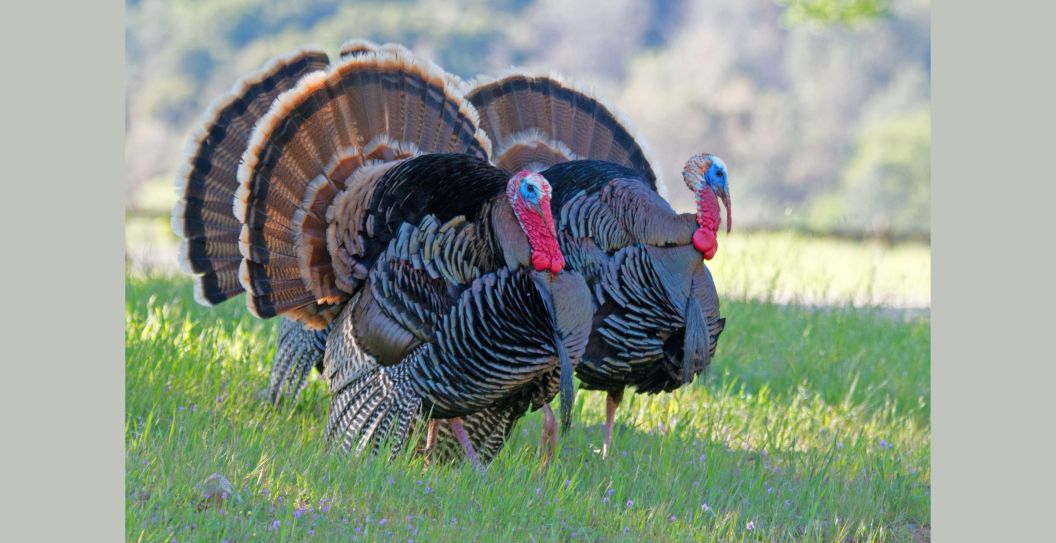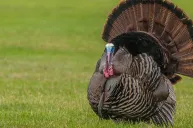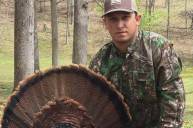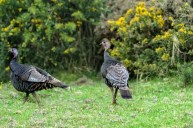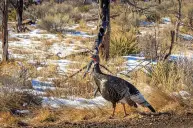Wild turkeys can be a chatty bunch of birds, especially in the springtime. They purr, cluck, gobble, and yelp. But when it comes to common turkey noises, there is another one that sometimes doesn't get much notice: the turkey drum. It is a subtle, almost whisper-quiet, sound that male turkeys emit during the mating season. Turkey drumming happens in very particular circumstances. Namely, when they are strutting.
Turkey drumming is thought to be a noise turkeys make in conjunction with spitting and puffing up. There is a movement associated with it that could almost be described as a quiver. Turkey hunters are as likely to see the movement of drumming as they are to actually hear the drumming noise, all without realizing what they are witnessing. Plus, it is such a low, mild sound that a hunter needs to be within 40 or 50 yards to even hear it. Given those circumstances, not everyone who gets out in the turkey woods has a chance to hear a turkey drumming.
What is Turkey Drumming?
This vocalization is made exclusively by male turkeys, and even scientists are uncertain of exactly how they do it. You'd think with birds as common as turkeys, we would know all their secrets, but this one is one of those sounds in the woods that we know very little about.
Some hunters hear the word drumming and think it has something to do with a noise made by the wing feathers, but it's generally believed a big gobbler makes this sound by quickly sucking in air and then forcing it out again quickly. The result is one of the lowest sounds in the woods. It's so subtle that you may not even realize the gobbler in front of you is doing it if there's enough background noise!
Most hunters refer to drumming as a gobbler spit-drum because there is also a distinct spitting sound right before the drum. Either way, this is not a long-distance sound such as a gobble. It is an up-close-and-personal type of vocalization. And if you hear it, it likely means the bird is already in bowhunting range.
What Does Turkey Drumming Mean?
Just like the mystery of how the sound is produced, it seems no one really knows exactly why turkeys make this strange sound. The consensus opinion is that it probably has something to do with mating rituals, since it is most often heard while longbeards are strutting and trying to impress hens in the springtime. Many hunters hear it when a bird is responding to their decoys.
However, it's also worth noting that turkeys strut all year, so maybe the spit-drum has some other meaning that we humans simply cannot understand. It would sure make things a lot easier for turkey hunters if we had a translator—but, sadly, we do not.
Perhaps drumming is simply a way to intimidate rivals or establish territory. One thing is for sure: It's a sound you want to listen for each turkey season.
What Does Turkey Drumming Sound Like?
Unlike gobbling, yelping, or clucks, a gobbler spit-drum sounds like nothing you'd expect from a turkey. It's an almost alien sound. The spit part of a spit-drum sounds exactly like the name. There's a brief, loud "Psssst!" sound. This is followed by the drum, which is truly hard to explain to someone who's never heard it. Phonetically, the closest we can get is, "Whoooooommmmm."
It almost sounds like the low hum of a surround sound speaker, or someone plucking one string of a bass guitar. It has a reverberation quality to it that you can actually feel if you're in close enough proximity.
There are plenty of videos on the internet of turkeys drumming, but even these have a hard time capturing the sound of this low turkey call. Most of the time, you need to listen to audio like this with headphones in order to pick out the very distinct hum. The first time I heard it, I didn't believe it came from a turkey!
Once you hear a turkey drumming for the first time, you too will probably be dumbfounded by this sound. It's like no other noise these birds make.
Notice in some of these videos that the gobblers almost look like their whole body or feathers are vibrating as they drum. It seems the Tom must really dig down deep to pull this sound out. It almost sounds like the type of noise a big game animal like a deer would make!
What Should Hunters Do if They Hear Turkey Drumming?
Turkey drumming is a sound you should be actively listening for every time you step in the woods after a big gobbler. Most hunters know the frustration of a turkey that suddenly stops gobbling, but some hunters might not realize that bird is still approaching them. Some Toms quit gobbling and start drumming, but the sound is so subtle that the hunter misses hearing it. Then, when the hunter stands up to leave, the turkeys spook.
Have you ever had a situation like that? If you have, it's probably likely that turkey was drumming near you and you didn't realize it.
Other hunters hear a turkey drum in the woods for the first time without knowing what it is, and it takes them completely by surprise. It is a relatively rare sound of the woods. If you've ever heard it while out turkey hunting, you're lucky. Not many hunters have ever heard it.
Most seasoned experts agree on this turkey hunting tip: If you're out after a big gobbler in the spring or fall turkey season and you suddenly hear this low sound reverberating through your area, get your bow or gun ready and hope your camo is good. That's because there's a Tom in the area, and he'll probably be within shooting range before you know it! In fact, he'll be very likely to be within archery range.
Ultimately, the science and research behind turkey drumming and how it's produced is rather incomplete. On top of that, wild turkeys are known to do some of the most unexplainable things we can imagine, so the mystery shrouding this bird and its actions shouldn't come as much of a surprise.
